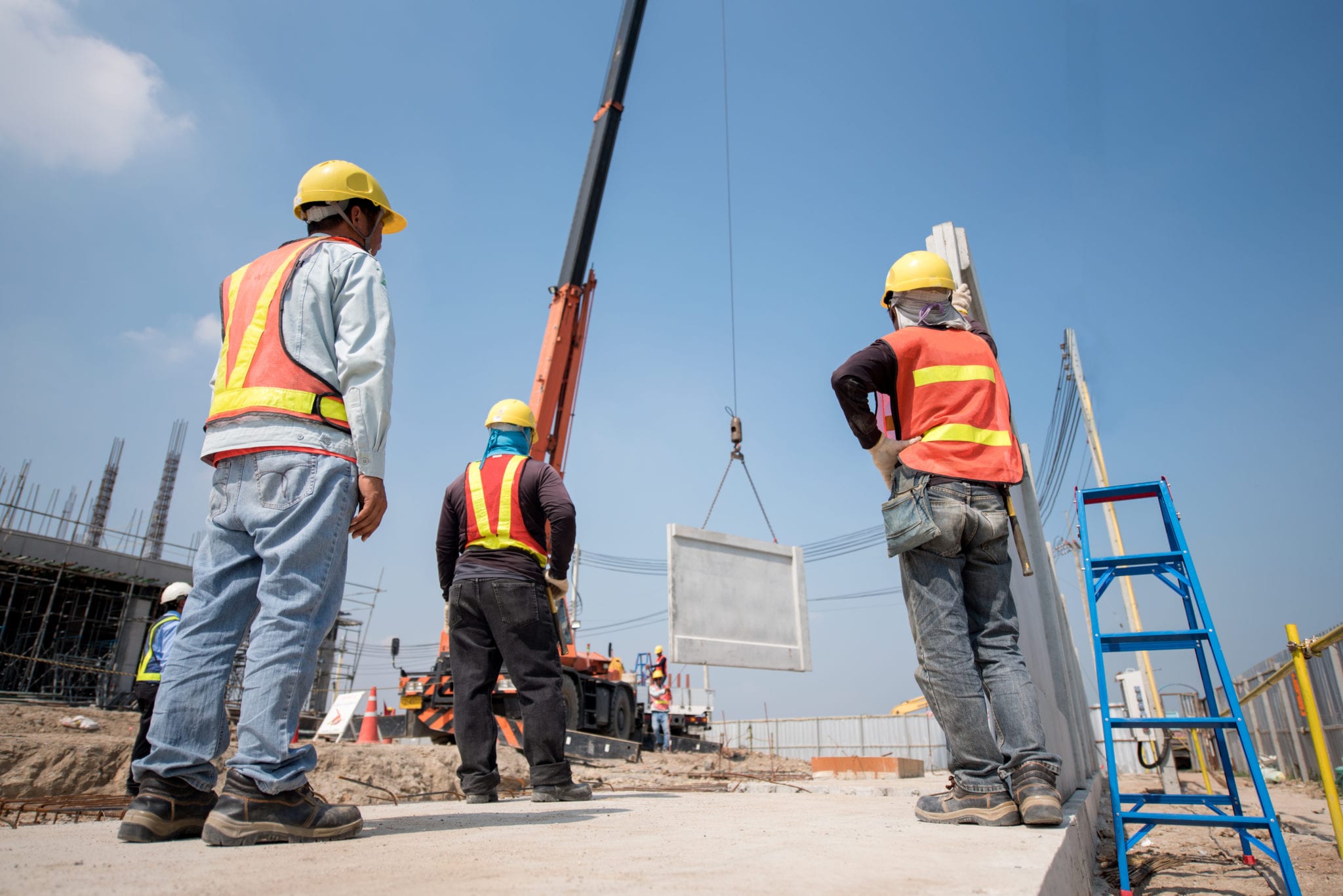Home>diy>Building & Construction>How Does Retention Work In Construction


Building & Construction
How Does Retention Work In Construction
Modified: January 3, 2024
Learn how retention works in building construction and how it plays a crucial role in ensuring the safety and stability of structures. Discover the key factors involved in retaining walls, soil stabilization, and more.
(Many of the links in this article redirect to a specific reviewed product. Your purchase of these products through affiliate links helps to generate commission for Storables.com, at no extra cost. Learn more)
Introduction
Welcome to the world of construction, where building dreams become a reality. Construction is a complex and intricate process that involves careful planning, skilled labor, and meticulous attention to detail. From towering skyscrapers to residential homes, the construction industry plays a crucial role in shaping the cities and landscapes we inhabit.
One of the key aspects of construction projects is the concept of retention. Retention, in the construction context, refers to the practice of withholding a certain percentage of the contract price from the contractor until the project is completed and has met all the defined requirements. The withheld amount acts as a security deposit against any potential deficiencies, defects, or non-compliance issues that may arise during or after the construction process.
Retention serves as a form of financial protection for the client or the project owner, safeguarding their interests and ensuring that the contractor fulfills their obligations. It creates an incentive for the contractor to complete the project successfully and rectify any defects or issues that may arise during the construction period.
Now that we understand the basic concept of retention in construction, let us delve deeper into its importance, various types, impact on contractors, and the challenges associated with its implementation. We will also explore the best practices for effective retention in construction projects and how it contributes to the overall success of a construction endeavor.
Key Takeaways:
- Retention in construction safeguards project owners and motivates contractors to deliver high-quality work by withholding a percentage of the contract price until project completion, ensuring accountability and timely rectification of deficiencies.
- Effective retention practices, including fair percentages, transparent communication, and proactive cash flow management, contribute to successful construction projects by balancing financial security with contractor sustainability and project quality.
Read more: What Is Retention In Construction?
What is Retention in Construction?
In the construction industry, retention refers to the practice of withholding a certain percentage of the contract price from the contractor until the completion of the project. This withheld amount, usually a percentage of each progress payment, acts as a warranty or security deposit against any defects, non-compliance issues, or deficiencies that may arise during or after the construction process.
Retention serves as a form of financial protection for the client or the project owner. It ensures that the contractor fulfills their obligations and completes the project to the agreed standards. By withholding a portion of the payment, the client retains control over a percentage of the contract price until all the requirements are met and any necessary rectifications are made.
The purpose of retention is to incentivize the contractor to deliver a high-quality project and provides a safety net for the client in case any issues arise. It serves as a mechanism to encourage the contractor’s accountability and timely completion of the construction project.
Retention is typically released in stages, based on predefined milestones or completion stages of the project. Once the project reaches a specific milestone or stage and is verified to meet the agreed-upon requirements, a portion of the retention amount is released to the contractor. The remaining retention is then released upon the completion of the project, after any necessary rectifications and inspections are carried out.
It is important to note that retention is not intended to penalize the contractor. Instead, it acts as an assurance for the client that the contractor is committed to rectifying any issues that may arise. The withheld amount provides a financial incentive for prompt action and ensures that the project is completed to the highest standard.
Retention is a common practice in the construction industry and is typically included in the contract agreement between the client and the contractor. The specific percentage of retention and the release schedule are outlined in the contract, providing clarity and ensuring that both parties are aware of the expectations and requirements.
In summary, retention in construction is the practice of withholding a percentage of the contract price from the contractor until the completion of the project. It serves as a financial safeguard for the client, incentivizes the contractor to meet their obligations, and ensures the delivery of a high-quality project.
Importance of Retention in Construction Projects
Retention plays a vital role in construction projects, serving several important purposes and providing benefits to both the client and the contractor. Let’s explore the significance of retention in more detail:
Financial Security: Retention acts as a form of financial security for the client. By withholding a percentage of the contract price, the client has funds available to rectify any defects, non-compliance issues, or deficiencies that may arise during or after the construction process. This provides peace of mind to the client, knowing that they have a financial buffer to address any potential problems.
Quality Assurance: Retention serves as a powerful incentive for the contractor to deliver a high-quality project. By withholding a portion of the payment, the client ensures that the contractor is motivated to fulfill their obligations and meet the agreed-upon standards. This promotes a commitment to excellence and encourages the contractor to rectify any deficiencies promptly.
Timely Completion: The retention mechanism encourages timely project completion. Since the contractor has a financial stake in the project, they have an added incentive to complete the work within the agreed-upon timeframe. The prospect of receiving the full payment, including the retained amount, motivates the contractor to meet deadlines and deliver the project on time.
Defect Rectification: Retention allows the client to address any defects or issues that may arise during the construction process. By withholding a portion of the payment until the project is completed, the client has the leverage to ensure that the contractor rectifies any deficiencies before the final payment is released. This ensures that the project meets the required quality standards and minimizes the potential for costly post-construction repairs.
Contractual Compliance: Retention ensures that the contractor complies with the terms and conditions outlined in the contract. By withholding a percentage of the payment, the client encourages the contractor to meet all the contractual obligations, including specifications, regulations, and any other requirements. This helps maintain transparency and accountability throughout the construction process.
Risk Mitigation: Retention mitigates the risk for the client by acting as a safeguard against potential contractor non-performance or insolvency. If the contractor fails to complete the project or encounters financial difficulties, the retained funds can be used to hire a new contractor or cover any additional costs associated with completing the project.
Overall, retention is a critical component of construction projects. It provides financial security to the client, ensures the quality and timely completion of the project, promotes defect rectification, enforces contractual compliance, and mitigates risk. By incorporating retention into the contract agreement, both the client and the contractor can benefit from a smoother and more successful construction process.
Types of Retention in Construction
In the construction industry, there are primarily two types of retention commonly used – percentage retention and milestone retention. Let’s take a closer look at each type:
1. Percentage Retention: Percentage retention involves withholding a certain percentage of each progress payment made to the contractor. The retained amount is calculated based on the total contract value and is typically released in stages throughout the project’s duration. For example, if the retention rate is set at 5%, then 5% of each progress payment made to the contractor will be withheld and accumulated until the project is completed. This type of retention provides the client with a continuous security deposit to address any defects or non-compliance issues that may arise during the construction process.
2. Milestone Retention: Milestone retention is another type of retention commonly used in construction projects. Unlike percentage retention, milestone retention is released at predefined milestones or completion stages rather than being tied to each progress payment. For example, the retention amount may be released when specific project milestones, such as the completion of foundation work, structural framing, or final inspection, are achieved and verified to meet the required standards. This type of retention ensures that the contractor meets critical project milestones and incentivizes timely project completion and quality workmanship.
While these are the two primary types of retention used in construction, variations and combinations can be implemented depending on specific project requirements and contractual agreements. It is essential for the client and the contractor to clearly define and agree upon the type of retention to be used in the contract to ensure clarity and transparency.
It’s worth noting that the percentage of retention and the release schedule are typically dictated by industry standards, local regulations, and the negotiation between the client and the contractor. These factors can vary from project to project and can be influenced by the size, complexity, and duration of the construction endeavor.
It is important for the client and the contractor to have a thorough understanding of the type of retention being employed in their construction project and the specific terms and conditions surrounding its release. This clarity helps establish expectations, promotes a smooth construction process, and ensures that both parties are aligned in their understanding and implementation of retention.
In summary, the two primary types of retention in construction are percentage retention and milestone retention. Percentage retention involves withholding a certain percentage of each progress payment, while milestone retention is released at predefined milestones or completion stages. Both types serve as financial safeguards and incentives for the contractor to adhere to project requirements and complete the work to the expected standards.
How Does Retention Impact Contractors?
Retention in construction projects has a significant impact on contractors. Let’s explore some key aspects of how retention affects contractors:
1. Cash Flow: Retention can have a direct impact on the cash flow of contractors. Withheld funds can tie up a portion of their working capital, limiting their immediate access to those funds. This can pose challenges in terms of financing ongoing projects, paying subcontractors and suppliers, and managing day-to-day business expenses. Contractors need to plan their finances carefully to account for the retention amounts and ensure a healthy cash flow.
2. Motivation and Performance: Retention acts as a powerful motivator for contractors to perform at their best. The prospect of receiving the full payment, including the retained amount, upon successful completion of the project incentivizes contractors to meet the project objectives, adhere to quality standards, and rectify any deficiencies promptly. Contractors strive to meet the client’s expectations and deliver a high-quality project to maximize their chances of receiving the retention funds.
3. Risk Allocation: Retention helps allocate the risk between the client and the contractor. By retaining a percentage of the contract price, the client transfers a portion of the risk associated with potential defects or non-compliance issues to the contractor. Contractors are responsible for rectifying any deficiencies during the construction process or after project completion, ensuring that the project meets the required standards. This risk allocation can impact the contractor’s reputation and future project opportunities.
4. Accountability: Retention holds contractors accountable for their workmanship and compliance with the contract requirements. Contractors are incentivized to address any defects or deficiencies promptly to release the retained funds. This accountability promotes a culture of responsibility, quality, and professionalism within the construction industry.
5. Cost of Corrections: Contractors bear the cost of rectification for any defects or non-compliance issues that arise during the construction process. If deficiencies are identified, contractors must allocate resources, time, and funds to rectify the problems and ensure compliance with the project requirements. This cost of corrections can impact the profitability of the contractor if not managed effectively.
6. Contract Negotiations: The terms and conditions related to retention are often negotiated between the client and the contractor before the start of the project. Contractors need to carefully consider the retention percentage, release schedule, and other related details during contract negotiations to ensure the impact on their business operations is reasonable and manageable.
In summary, retention has a tangible impact on contractors in terms of cash flow, motivation, risk allocation, accountability, cost of corrections, and contract negotiations. Contractors must navigate these aspects effectively to balance the financial implications of retention while delivering high-quality projects and building strong client relationships.
Tip: Retention in construction refers to the practice of holding back a portion of the contract payment until the work is completed to the client’s satisfaction. It serves as a form of security against any potential defects or issues that may arise after the project is finished.
Read more: How Does Bidding Work In Construction
Factors Affecting Retention in Construction
Retention in construction projects is influenced by various factors that can vary from project to project. These factors impact the decision-making process regarding the percentage of retention, the release schedule, and other related aspects. Let’s explore some of the key factors that influence retention in construction:
1. Project Size and Complexity: The size and complexity of the construction project play a crucial role in determining the retention percentage. Larger and more complex projects may require a higher retention rate due to the increased risks involved. Complex projects often involve intricate design elements, specialized technologies, and a higher likelihood of potential defects or non-compliance issues, making a higher retention rate necessary to safeguard the client’s interests.
2. Industry Standards and Regulations: Industry standards and regulations can influence the retention practices in construction projects. Local regulations or industry guidelines may specify minimum or maximum retention percentages or provide guidance on the release schedule. Compliance with these standards is important to ensure that retention practices align with industry best practices and legal requirements.
3. Contractual Agreements: The terms and conditions outlined in the contract agreement between the client and the contractor are critical in determining the specifics of retention. The contract should clearly define the retention percentage, the release schedule, and any other relevant details. The negotiation process between the parties involved will also impact the retention terms, considering factors such as project scope, timeline, and risk allocation.
4. Client Requirements and Preferences: The client’s requirements and preferences can influence the retention arrangements in a construction project. Some clients may prioritize a higher retention rate to ensure financial security and minimize risks, while others may be more flexible based on their level of trust in the contractor or the project’s overall risk profile. The client’s preferences play a crucial role in defining the retention parameters.
5. Contractor Reputation and Track Record: The reputation and track record of the contractor can also impact retention decisions. Clients may have more confidence in established and reputable contractors with a proven track record of delivering high-quality projects on time. In such cases, clients may choose to set a lower retention rate as they have trust in the contractor’s ability to meet the project requirements.
6. Project Duration: The project duration is another factor that may influence retention. Longer projects may have higher retention rates due to the extended time span and increased risk exposure. The retention amount serves as a buffer to address any issues that may arise over the course of an extended construction period.
7. Risk Allocation and Contextual Factors: The allocation of risks between the client and the contractor plays a significant role in determining the retention terms. The nature of the project, the potential risks involved, and the contractual arrangements impact considerations such as retention percentage and release schedule.
It is important for the client and the contractor to have open and transparent communication regarding the factors influencing retention in construction projects. Collaborative discussions ensure that the retention arrangements are fair, reasonable, and in the best interest of both parties.
In summary, factors including project size and complexity, industry standards, contractual agreements, client preferences, contractor reputation and track record, project duration, and risk allocation all impact the decision-making process surrounding retention in construction projects.
Retention Methods and Procedures
In construction projects, the methods and procedures for retention are established to ensure clarity, fairness, and effective implementation. Let’s explore the common methods and procedures involved in retention:
1. Contractual Agreement: The first step in implementing retention is to include specific provisions in the contract agreement between the client and the contractor. The contract outlines the retention percentage, the release schedule, and any other relevant details. This contractual agreement serves as the foundation for the retention process and provides a clear understanding of the expectations for both parties.
2. Retention Release Schedule: The retention release schedule sets out the milestones or completion stages at which portions of the retained amount will be released to the contractor. Typically, the release of retention occurs in stages and is based on predefined milestones or project completion stages. The release schedule ensures that the contractor is incentivized to meet key project objectives and milestones and allows for proper inspections and verification of compliance before the release of funds.
3. Inspection and Verification: Before the release of retention, the construction project undergoes inspections and verification by relevant parties. This involves checks to ensure that the project meets the specified quality standards, complies with regulations and specifications, and has addressed any identified deficiencies or non-compliance issues. Inspections may involve site visits, documentation reviews, and collaboration between the client, contractor, and any other relevant stakeholders.
4. Defect Rectification: If any defects or non-compliance issues are identified during the inspection process, the contractor is given an opportunity to rectify them before the release of retention. The contractor must address these deficiencies promptly and ensure that the project meets the required standards and specifications. The rectification process may involve additional inspections and verification to ensure that the defects have been effectively resolved.
5. Documentation and Record Keeping: Keeping accurate documentation and records is a crucial aspect of retention procedures. This includes maintaining records of progress payments, retention amounts withheld, release dates, inspection reports, and any correspondence related to retention. Documentation serves as evidence of compliance, facilitates transparency, and helps resolve any disputes or issues that may arise during or after the construction process.
6. Retention Period: The length of the retention period is determined by the contract agreement and the specific requirements of the construction project. The retention period typically starts from the date of substantial completion of the project or the achievement of predefined milestones. It extends until all inspections, rectifications, and verifications are completed, and the project is deemed fully compliant. Once the retention period ends, the final retained amount is released to the contractor.
7. Payment Certification: In some cases, a payment certification process may be involved in the release of retention. This involves a thorough review and certification of the contractor’s compliance with contractual obligations and project requirements. Payment certification provides an added layer of assurance that all necessary steps have been taken to meet the conditions for releasing the retained amount to the contractor.
It is essential for all parties involved in the construction project, including the client, contractor, and any relevant consultants or project managers, to have a clear understanding of the retention procedures. This ensures that the retention process is executed efficiently, and the release of funds is based on objective criteria and compliance with the agreed-upon requirements.
Overall, the methods and procedures for retention in construction projects involve establishing the contractual agreement, setting a release schedule, conducting inspections and verification, rectifying any identified deficiencies, maintaining proper documentation, adhering to the agreed retention period, and implementing a payment certification process if necessary. These procedures ensure that the retention process is fair, transparent, and aligned with the objectives of the construction project.
Problems and Challenges with Retention in Construction
While retention serves as an important tool in construction projects, it is not without its share of problems and challenges. Let’s explore some of the common issues that can arise with retention in construction:
1. Cash Flow Constraints: Retention can pose cash flow challenges for contractors, particularly smaller firms or subcontractors. The withheld funds tie up working capital, making it difficult for contractors to finance ongoing projects, pay subcontractors and suppliers, and cover day-to-day business expenses. Contractors must carefully manage their finances to mitigate the impact of cash flow constraints caused by retention.
2. Disputes over Release: Disputes may arise regarding the release of retention funds. Clients may withhold the release of funds due to perceived defects or non-compliance issues, even if the contractor believes that the project meets the required standards. These disputes can result in delays in the release of retention and can strain relationships between the client and the contractor.
3. Impact on Profit Margins: The cost of corrections and the requirement to rectify any identified deficiencies can impact a contractor’s profit margins. Contractors bear the financial burden of rectifying any defects or non-compliance issues, which can erode their profitability if not adequately managed. Contractors must carefully consider the cost implications of retention and factor them into their project pricing and bidding strategies.
4. Limited Access to Working Capital: Withheld retention funds limit contractors’ access to working capital, making it challenging to invest in new projects or expand their business. This limitation can hinder the growth and scalability of contractors, particularly smaller firms or subcontractors who rely on cash flow to sustain their operations and pursue new opportunities.
5. Disruption to Contractor-Subcontractor Relationships: Retention can create strains in contractor-subcontractor relationships. Subcontractors may experience cash flow constraints due to the retention held by the contractor, leading to disputes or delays in payment. These disruptions can impact the subcontractor’s ability to fulfill their obligations, strain relationships, and hinder project progress.
6. Impact on Project Scheduling: The retention process, including inspections and rectifications, can impact project scheduling. If there are delays in the release of retention funds due to disputes or unresolved issues, it can affect the contractor’s ability to manage project finances effectively, potentially leading to project delays or resource constraints.
7. Administrative Burden: Retention involves administrative tasks such as documentation, verification, and certification. The administrative burden of managing retention can be time-consuming and resource-intensive for both the client and the contractor. It requires meticulous record-keeping, communication, and coordination to ensure compliance with the retention procedures and maintain transparency throughout the process.
It is crucial for both clients and contractors to be aware of these potential problems and challenges with retention. Open communication, early dispute resolution mechanisms, and careful financial planning can help mitigate these challenges and ensure a smoother retention process in construction projects.
Despite these challenges, retention remains an integral part of construction projects, providing financial security and incentivizing contractors to deliver high-quality work. By recognizing and addressing these issues, stakeholders in the construction industry can work towards optimizing the retention process and improving its effectiveness.
Best Practices for Effective Retention in Construction
Retention is an important aspect of construction projects, and implementing it effectively is key to ensuring the success and smooth progress of the endeavor. Here are some best practices for effective retention in construction:
1. Transparent Communication: Establish open and transparent communication between the client and the contractor. Clearly communicate the expectations, requirements, and terms related to retention. Foster a collaborative environment that encourages dialogue and understanding, which can help prevent disputes and ensure clarity from the outset.
2. Fair and Reasonable Retention Percentage: Determine a fair and reasonable retention percentage that aligns with industry standards and the nature of the project. Striking the right balance is important to provide adequate financial security while not unduly constraining the cash flow of the contractor.
3. Clear Contractual Agreement: Ensure that the contract agreement clearly defines all aspects related to retention, including the retention percentage, release schedule, and any specific requirements or conditions. The contract should be comprehensive, leaving no room for ambiguity or confusion regarding the retention process.
4. Regular Inspections and Verification: Carry out regular inspections and verification of the construction project to ensure compliance with the agreed-upon standards. This helps identify any defects or non-compliance issues early on, allowing for prompt rectification and preventing potential delays or disputes in the release of retention funds.
5. Timely Rectification of Deficiencies: Contractors should promptly address any identified deficiencies or non-compliance issues. Timely rectification demonstrates commitment and accountability, ensuring that the project meets the required quality standards and reducing the likelihood of disputes or delays in the release of retention funds.
6. Proactive Cash Flow Management: Contractors must proactively manage their cash flow to mitigate any potential challenges caused by the retention process. Careful financial planning, budgeting, and cash flow management can help offset the impact of withheld funds and ensure that the contractor can operate effectively throughout the project.
7. Efficient Documentation and Record-Keeping: Maintain accurate and comprehensive documentation and records related to the retention process. This includes progress payments, retention amounts withheld, release dates, inspection reports, and any correspondence. Proper documentation facilitates transparency, helps resolve disputes, and ensures compliance with contractual obligations.
8. Collaboration with Subcontractors and Suppliers: Contractors should foster strong relationships with subcontractors and suppliers to prevent disruptions caused by retention. Clear communication regarding the retention process, timely payments to subcontractors, and equitable practices can help maintain positive subcontractor relationships and ensure smooth project progress.
9. Regular Review and Evaluation: Regularly review and evaluate the retention process to identify areas for improvement. Solicit feedback from both clients and contractors to gain insights into the effectiveness of the retention practices and make necessary adjustments for future projects.
10. Adherence to Legal and Regulatory Requirements: Ensure compliance with applicable legal and regulatory requirements related to retention. Stay updated on industry standards, local regulations, and any changes that may impact the retention process. Adhering to legal requirements helps maintain integrity, trust, and accountability in the construction industry.
By following these best practices, stakeholders in the construction industry can establish effective retention processes that provide financial security, encourage high-quality work, foster collaboration, and promote the successful completion of construction projects.
Read more: How Does A Bond Work In Construction
Conclusion
Retention is a fundamental aspect of construction projects, designed to provide financial security, incentivize high-quality work, and mitigate risks for both clients and contractors. By withholding a percentage of the contract price until the completion of the project, retention ensures that contractors fulfill their obligations, rectify any deficiencies, and deliver projects that meet the required standards.
Throughout this article, we have explored the concept of retention in construction, its importance, various types, impact on contractors, factors affecting its implementation, methods and procedures, challenges, and best practices for effective retention. It is evident that retention is a complex process that requires careful communication, planning, and collaboration between the client and the contractor.
Implementing best practices such as transparent communication, fair retention percentages, clear contractual agreements, regular inspections, proactive cash flow management, and collaboration with subcontractors and suppliers can contribute to the effective implementation of retention. These practices ensure that the retention process is fair, transparent, and aligned with the objectives and requirements of the construction project.
While retention may pose challenges such as cash flow constraints, disputes over release, and administrative burdens, these issues can be managed through open communication, early resolution mechanisms, and careful financial planning. Contractors should also strive to maintain strong relationships with subcontractors and suppliers to minimize disruptions caused by retention.
Ultimately, the successful implementation of retention in construction requires a balanced approach that addresses the financial security needs of the client while supporting the growth and sustainability of contractors. By fostering a collaborative and cooperative environment, stakeholders in the construction industry can navigate the complexities of retention and contribute to the successful delivery of high-quality construction projects.
In conclusion, retention plays a crucial role in the construction industry, supporting financial security, promoting accountability, and incentivizing excellence. By focusing on effective communication, fair practices, and proactive management, retention can be utilized as a valuable tool to enhance construction project outcomes and contribute to the overall success of the industry.
Frequently Asked Questions about How Does Retention Work In Construction
Was this page helpful?
At Storables.com, we guarantee accurate and reliable information. Our content, validated by Expert Board Contributors, is crafted following stringent Editorial Policies. We're committed to providing you with well-researched, expert-backed insights for all your informational needs.














0 thoughts on “How Does Retention Work In Construction”